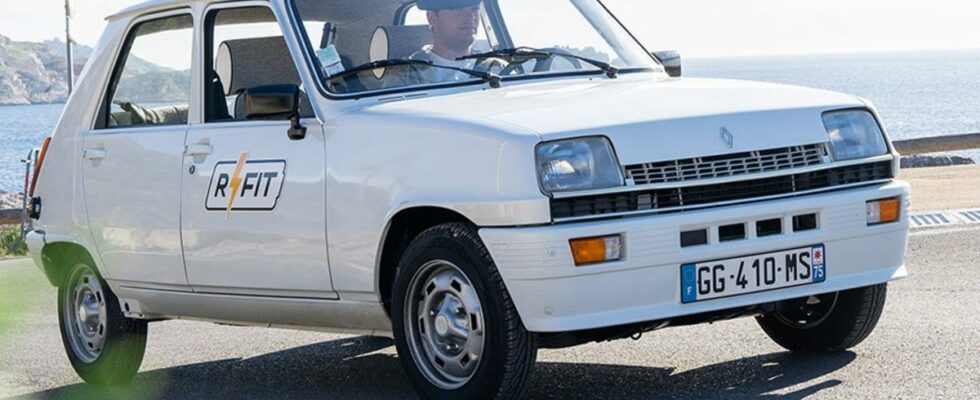Next February 1st will open Rétromobile, a show dedicated to old and collectible vehicles, from 2 to 4-wheelers, or even more for some. French and international car manufacturers will be present.
One of the stands is likely to generate a number of comments, questions and fiery debates, especially among die-hard collectors. Indeed, Renault will exhibit its iconic 4L, Renault 5 and first-generation Twingo, but the models on display will have swapped their internal combustion engines for an electric thruster.
This is what is called a retrofit, a solution which consists of replacing the internal combustion engine with an electric version and a battery pack. This practice has been authorized in France since a decree published in March 2020 thanks to the lobbying carried out by the Association of players in the electrical retrofit industry (AIRe).
The three retrofitted Renaults were made possible thanks to the partnership signed with the Mehari Club Cassis – R-Fit, one of the forerunners of retrofitting in France with more than 50 “treated” vehicles to its credit. These are essentially Citroën 2CVs and Méharis. This same R-Fit will be present on a stand next to that of Renault.
The Mehari Club Cassis – R-Fit, pioneer of retrofitting in France. © Erick Fontaine / Digital
Conversion kits approved by UTAC will be offered for sale from February 1 for the 4L, while that of the R5 (TL or GTL, 3 or 5 doors, type 139700 or 122700) will arrive in autumn 2023 The Twingo kit will be “available later” said Renault. For the record, the French start-up Transition-One has already retrofitted a second-generation Renault Twingo with a 25 kWh battery pack, which we had the opportunity to take in hand.
French star-up Transition-One was the first to retrofit a second-generation Renault Twingo. © Aurélien Piot / Digital
Marketed from €11,900 (VAT and installation included), the kit includes a 48 kW (65 hp) brushless synchronous motor powered by a battery pack (105 V) with phosphate-iron-lithium (LiFePO4), d a capacity of 10.7 kWh. Renault indicates that the autonomy – displayed on an interior gauge – will be 80 km (theoretical or real?). The 4L will recharge in 3h 30min from a household power outlet (16A/220V). What does not change is the mechanical transmission system. The manufacturer claims that this conversion kit will not affect the weight distribution of the vehicle.
Once the 4L is retrofitted, its owner will receive all the necessary homologation and registration documents, indicating the fuel type as electric (EL) rather than petrol (ES). Remember that the purchase of an electric conversion kit allows you to obtain various national and regional bonuses and bonuses, all depending on income and region.
An economical alternative?
On the other hand, neither Renault nor R-Fit have communicated the prices of the other two kits. It is assumed that they will be close to that of the 4L, the goal being “a commercially attractive alternative to buying the equivalent new vehicle”, Renault said last year. By way of comparison, you have to pay €25,250 for a Renault Twingo ZE and €35,100 for a Renault Zoe. The next “new” electric R5, scheduled for 2024, is estimated from €20,000. It should be followed by the 4ever from 2025.
A report from Ademe in March 2021 estimates that “the development costs of the conversion kit are very high”. © Ademe
For Hugues Portron, director of The Originals Renault, “these electric retrofit kits will allow people who love their classic car and young people to drive around France in our iconic Renault 4, Renault 5 and Twingo, powered by electricity”.
Not sure that collectors are of the same opinion. Although “retrofit appears as a solution to perpetuate the old car”according to the site The New Motorist, “this practice erases the traces of an old conception. It blurs the thread of automobile history and technological evolution. This is the reason why the conversion must spare vehicles which represent a particular historical and heritage interest”.
In addition to the sentimental value, a so-called collector’s car has a historical, heritage interest, a market value whose rating could suffer from an electrical transformation which could also prove to be very expensive.
For around €250, collectors will prefer to go through the “collection car” box (30 years minimum) via the French Federation of Old Vehicles (FFVE). Note that a Crit’Air Collection sticker (paid) should appear shortly, just to continue to circulate anywhere, ZFE or not.

